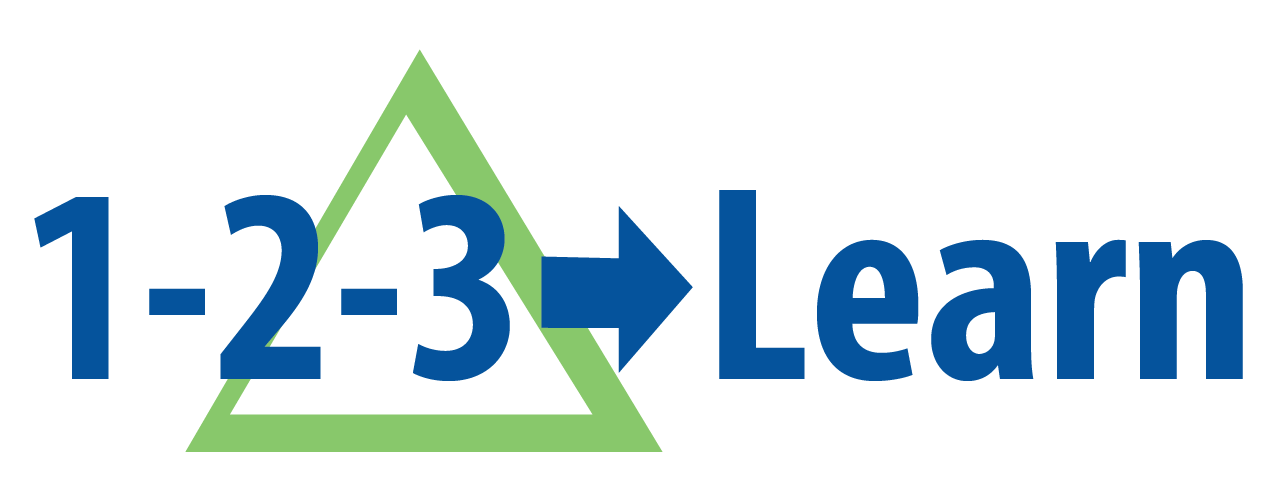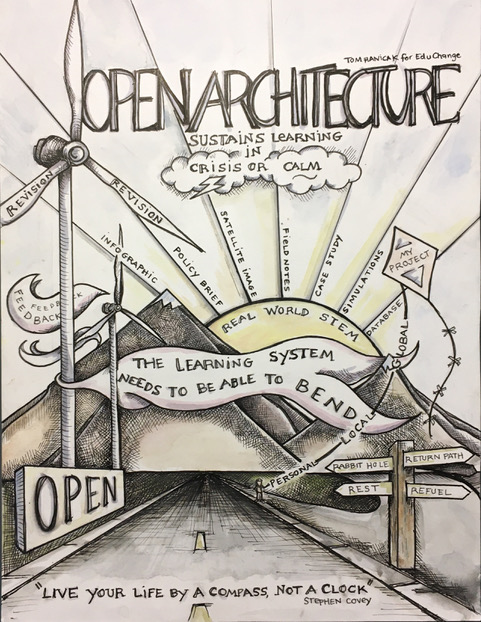How Open Learning Architecture Sustains Learning—in Crisis or Calm
An immediate shock to school communities during the COVID-19 school closures has been the shift in the physical space where learning happens on a daily basis. The physical school classroom serves as an equalizer, and disparities in out-of-school spaces are laid bare when students are prompted to learn on lockdown.
It is true that where learning happens is inherently connected to how learning happens.
But it is an interesting moment to reflect on which learning variables seem inextricably tied to the physical space within schools, and why learning feels so disconnected outside of the physical school ‘bubble.’
We are collectively knee-deep in consideration of which learning drivers are both important and possible to maintain during physical distancing. There are so many variables to consider, not the least of which is safety within the home. Wellness variables are the first priority, and include safety, sleep, nourishment and stress-reduction. Meal programs that feed children and families in need may be threatened in some locations, and that is worrisome. Maslow trumps Bloom, as educators say, and needs differ from student to student.
Taking time to first address wellness needs, and then to work with students and families to determine a staged, differentiated process for alternate learning modes, seems like a prudent use of resources, doesn’t it?
Even if wellness needs are the only needs addressed during a public health crisis, we will have succeeded in preparing students to resume their learning under more stable conditions—in school or otherwise.
It is remarkable how many learning routines and processes are determined by particular classroom spaces. Is the reverse ever true? Do learning needs ever drive the designs of learning spaces within schools?
Some administrators hope that new facilities will improve pedagogy, but this is hardly automatic. Sadly, more than one multi-million-dollar school modernization ‘upgrade’ has been completed with no concrete plan for the kinds of learning the space should support.
These ill-conceived designs are permanent, leaving at least a generation of students and teachers to struggle within an inappropriate layout. Relative to that level of resource waste and missed opportunity, I don’t think it’s useful to lament ‘learning loss’ in the midst of this global pandemic.
Instead, I’d like to shine a light on the ways in which rigid academic calendars are connected to the fixed, singular physical spaces we call ‘school.’
The truth is that conventional secondary school academics are extraordinarily inflexible under the best conditions. Without flexibility, schools have no prayer of resilience when conditions change.
I believe that structural rigidity is one of the root causes of academic dysfunction more generally. I’d like to share how we think about expanding possibilities for both physical spaces and timeframes for learning in order to support diverse students in changing conditions.
Spoiler alert: proactive or reactive shifts in space and time are possible only when supported by instructional, assessment and content systems that are both compatible with each other (co-evolved), and flexible in their own right.
Shifts in the Space Where Learning Happens
Consider a learning system where content is ensconced inside the Information Age, students produce knowledge as part of their learning process, disciplinary practices are leveraged for learning, and students build a stable set of competencies through chronic positive patterns of performance.
Under these conditions, teacher and learner transitions to different spaces and places are possible.
When the place where the learning happens shifts, other practices and routines also shift. This is why the whole learning system must be able to ‘bend’ a bit.
For example, when students develop projects or internships in their communities, these experiences are naturally asynchronous with the school calendar, extending into evenings, weekends and summers as the students desire.
And unlike courses that have fixed timeframes, student-led projects may conclude prematurely, either because interest wanes or formidable barriers persist.
Allowing such experiences to fail actually supports the premise of this period of real-world experimentation.
It also means that student credits or graduation requirements cannot be bound rigidly to these experiences.
During out-of-school learning experiences there also is a shift in the type of content needed to drive their projects/internships. This content often includes student-collected data, local information gathered through secondary research, and expertise found outside of school, often from people who are not trained teachers.
Museum curators, musicians, graphic designers, and engineers may become student mentors. When classroom practices and competencies are more closely aligned with real-world, community-accepted norms, transitions are easier and more inclusive of those outside of schools.
In many schools, students must finish the local or state course requirements first, before they entertain out-of-school projects or internships. This is similar to the logic that says, “You need to take the AP science classes and survive your 101-level undergrad courses before you start grappling with real-world problems and getting a taste of the field.”
This linear logic is counterproductive, and pushes students away from STEM before they even realize they might enjoy it.
Another line of argument is equally counterproductive but for different reasons: “Projects & internships are fine for students who know their passion, but most students have no clue what to work on, or lack the confidence to venture outside of school.”
I agree that many students have not developed the time management, communication or research skills that can make their own projects successful.
And therein lies the problem.
If the core curriculum of high schools is not preparing students to autonomously produce high-quality work that is acceptable to their local communities, then that curriculum is not achieving college, career, caregiver or citizen readiness.
Our designs engineer shifts in classroom instructional and assessment practices precisely because the classroom is the wedge in the system that will help open up learning possibilities beyond its walls.
This approach is more equitable and effective than adding research courses or electives for students who finish everything else (time is both a resource constraint and an accommodation remember?).
A more open learning architecture directly connects independent student efforts outside the classroom to the core curriculum within it, but only when appropriate systems and structures are in place comprehensively, and over multiple years.
To create ‘bendable’ structures that maintain coherence in the face of shifts in space and place, we:
- organize content according to real-world STEM stories that contextualize required content, thus priming students to make conceptual connections to their own projects;
- prompt students to make personal, local and global connections, which helps build empathy and awareness of community needs that may seed project ideas;
- give students ample opportunities to negotiate diverse genres of authentic, interdisciplinary STEM resources, making independent research in the real world much easier;
- provide students with discussion, peer review, data, writing, questioning, collaboration and other PBL protocols during class, which prepares them for their own project management; and
- embed revision and feedback cycles so students are not frustrated when asked to redo or improve their work.
Perhaps most importantly, the competencies that drive our assessment system seamlessly apply to out-of-class project/internship work. Here again, students and teachers need assessment tools to ‘bend’ and ‘give’ so that the learning that happens during successful out-of-school experiences can ’count’ in meaningful ways.
Students who demonstrate proficiency within their own projects may log those successes in an assessment profile that builds over multiple years—beyond a single course. In this way, both in-class and out-of-class performances count equally.
This is true spatially (i.e., beyond classroom walls) and temporally (i.e., during summer breaks and internships).
Interestingly, we can consider this same spatial and temporal connectivity at the interface of VocationalEd/CTE and core curriculum. When the core curriculum steers content organization according to the compass of the Information Age, and employs disciplinary literacy practices that apprentice students into the field of STEM, then suddenly VocationalEd/CTE becomes a viable, appealing pathway for many students.
Shifts That Optimize Non-linear Learning
I trust you are making inferences about how shifts in space and time constructs apply to this period of COVID-19 school closures.
Most schools can manage a few students’ long-term absences due to hospitalizations, family emergencies or involvement with the juvenile justice system. But I think it’s safe to say that very few schools were prepared for multi-month school closures for all students.
I lament the reality that we were warned more than once by many experts and did not listen. Now we are unprepared to handle the technical and material divides that prevent many students from accessing the same range of learning experiences.
Learning systems architecture alone cannot remedy those inequities. Similarly, fixing poverty and food systems won’t build better learning architecture. All the work is necessary and connected systemically. It’s one of the many reasons why partnerships are essential.
Our designs support wellness-learning synergies in times of widespread crisis and displacement. We wanted designs that truly account for disruptions, delays and other time-loss problems.
This flies in the face of a persnickety rigid academic construct: the linear, unidirectional sequence of units, chapters and topics within a course. A core problem with rigid unidirectional structures is that any interruption to the sequence means a loss of time, a loss that is emotionally charged for humans and can lead to anxiety.
In conventional academic structures, time equates to content coverage and content coverage determines the wholeness of a course. Thus, courses must always move forward, and never sideways or backwards into related or previously-covered content.
I realize that academic timeframes run chronologically from end to end, but here I dissect content motion from calendar motion. The difference is important.
So we made design maneuvers that increase resilience through multi-directional content movement when the school calendar is interrupted. In effect, students and teachers can move forward even while moving back into content previously “covered.” Of course, you would not repeat those learning experiences, but you might delve more deeply or make novel connections.
These design maneuvers include:
- decoupling content mastery from end-of-unit timeframes,
- maintaining a stable set of competencies over several years, and
- explicitly hyper-connecting content and competencies through web-like structures.
Our re-designs allow educators to be responsive to their students when schedule disruptions occur.
In one example, a class may decide that the wellness principles learned in our Food, Nutrition & Fitness Strand apply directly to self-care during this public health crisis. Even if those modules concluded months ago, the current situation beckons students to apply those concepts in this new context, and to deepen understanding through new connections. This intentional revisit demonstrates the value of content previously learned, thus exemplifying why we learn to begin with.
The same architecture also can support individual or small-group journeys at a time when keeping an entire classroom in sync is too difficult. Each student could revisit a STEM story that held personal relevance and dig deeper in some way. High-tech, low-tech and no-tech options are possible according to the individual student’s situation. Teachers can direct more support to students who feel less autonomous or require more guidance, as they do in the classroom.
In both examples, the learning continues.
In both examples, students continue to demonstrate proficiency in ways that ’count.’
In both examples, the academic experience is responsive to students’ real needs and real capacities within a crisis.
In both examples, the power of coherent, open learning architecture provides the necessary familiarity that stabilizes students without holding them back.
In both examples, time is not lost, it is repurposed. In fact, it is this sideways and backwards movement that makes advancement possible.
We’ll let you know when the next post is ready for you!





2 Comments
Using your brilliant posts to strengthen an academic article on the use of OACD in corporate language learning. Thanks!
Thanks for reading! We think Catherine’s brilliant, too…but we’re biased. When your paper is linkable, please email us and we’ll link to it in this post or others as appropriate! info@educhange.com